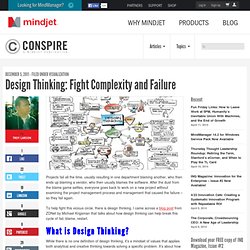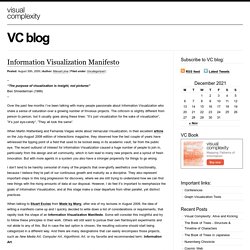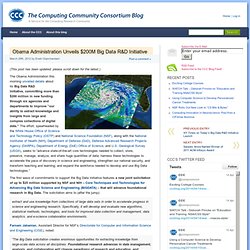

Visualizations. Comment on Infographie gouvernance de l’information : Une vue systémique pour comprendre le pilotage de l’information by Alain Coulon. Design Thinking: Fight Complexity and Failure. Projects fail all the time, usually resulting in one department blaming another, who then ends up blaming a vendor, who then usually blames the software.

After the dust from the blame game settles, everyone goes back to work on a new project without examining the project management process and management that caused the failure – so they fail again. To help fight this vicious circle, there is design thinking. I came across a blog post from ZDNet by Michael Krigsman that talks about how design thinking can help break this cycle of fail, blame, restart. What is Design Thinking? While there is no one definition of design thinking, it’s a mindset of values that applies both analytical and creative thinking towards solving a specific problem. Six Principles of Design Thinking 1. Multidisciplinary teams champion the user, the business, and the technology aspect of a project in a more comprehensive manner than otherwise possible. 2. 3. 4. 5. 6. Final Remarks Image Source: Related. Dynamical Systems Web Portal - Media Gallery.
A visual exploration on mapping complex networks. 3 Dimensional Fractals & Mandelbulb. Chaos & Complexity Pdf Library > GaianXaos. Information Visualization Manifesto. Posted: August 30th, 2009 | Author: Manuel Lima | Filed under: Uncategorized | – “The purpose of visualization is insight, not pictures” Ben Shneiderman (1999) – Over the past few months I’ve been talking with many people passionate about Information Visualization who share a sense of saturation over a growing number of frivolous projects.

The criticism is slightly different from person to person, but it usually goes along these lines: “It’s just visualization for the sake of visualization”, “It’s just eye-candy”, “They all look the same”. When Martin Wattenberg and Fernanda Viégas wrote about Vernacular Visualization, in their excellent article on the July-August 2008 edition of interactions magazine, they observed how the last couple of years have witnessed the tipping point of a field that used to be locked away in its academic vault, far from the public eye. Even though a clear divide is necessary, it doesn’t mean that Information Visualization and Information Art cannot coexist. Obama Administration Unveils $200M Big Data R&D Initiative. (This post has been updated; please scroll down for the latest.)

The Obama Administration this morning unveiled details about its Big Data R&D Initiative, committing more than $200 million in new funding through six agencies and departments to improve “our ability to extract knowledge and insights from large and complex collections of digital data.” The effort, spearheaded by the White House Office of Science and Technology Policy (OSTP) and National Science Foundation (NSF), along with the National Institutes of Health (NIH), Department of Defense (DoD), Defense Advanced Research Projects Agency (DARPA), Department of Energy (DoE) Office of Science, and U.S.
The first wave of commitments to support the Big Data Initiative features a new joint solicitation of up to $25 million supported by NSF and NIH – Core Techniques and Technologies for Advancing Big Data Science and Engineering (BIGDATA) – that will advance foundational research in Big Data. From the solicitation: 1. 2. Funding - Core Techniques and Technologies for Advancing Big Data Science & Engineering. Directorate for Computer & Information Science & Engineering Critical Techniques and Technologies for Advancing Big Data Science & Engineering (BIGDATA) Solicitation 14-543 Full Proposal Deadline Date: June 9, 2014 This year, the solicitation invites two types of proposals: "Foundations" (F): those developing or studying fundamental techniques, theories, methodologies, and technologies of broad applicability to Big Data problems; and "Innovative Applications" (IA): those developing techniques, methodologies and technologies of key importance to a Big Data problem directly impacting at least one specific application.

All proposals must address critical challenges for big data management, big data analytics, or scientific discovery processes impacted by big data. Proposals submitted to the "Innovative Applications" (IA) category must specify one or more relevant participating NSF directorates in the Project Summary. Frequently Asked Questions (FAQS) for NSF 12-499.